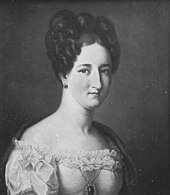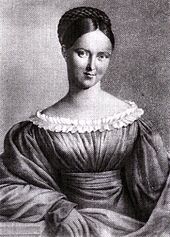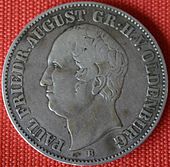Augustus, Grand Duke of Oldenburg
| Augustus | |||||
|---|---|---|---|---|---|
 | |||||
| Grand Duke of Oldenburg | |||||
| Reign | 17 January 1829 – 27 February 1853 | ||||
| Predecessor | Peter I | ||||
| Successor | Peter II | ||||
| Born | July 13, 1783 Rastede | ||||
| Died | February 27, 1853 (aged 69) Oldenburg | ||||
| Burial | Ducal Mausoleum, Gertrudenfriedhof, Oldenburg | ||||
| Spouse | Adelheid of Anhalt-Bernburg-Schaumburg-Hoym Ida of Anhalt-Bernburg-Schaumburg-Hoym Cecilia of Sweden | ||||
| Issue | Amalia, Queen of Greece Duchess Frederica Peter II Duke Alexander Duke August Duke Elimar | ||||
| |||||
| House | House of Holstein-Gottorp | ||||
| Father | Peter I | ||||
| Mother | Frederica of Württemberg | ||||
| Religion | Lutheranism | ||||
Augustus, Grand Duke of Oldenburg (13 July 1783 – 27 February 1853) was the Grand Duke of Oldenburg from 1829 to 1853.
Birth and family
Augustus was born on 13 July 1783 at Schloss Rastede near Oldenburg, to the then Prince Peter Frederick Louis of Holstein-Gottorp and his wife Duchess Frederica of Württemberg, a daughter of Frederick II Eugene, Duke of Württemberg.
Augustus had one younger brother, Duke George of Oldenburg, who was a year younger than him. In 1785, at the age of twenty, his mother died in childbirth. His father never remarried.
Early life

In 1785, when Augustus was two years old, his father became Prince-Bishop of Lübeck and was furthermore appointed regent of the Duchy of Oldenburg for his incapacitated cousin William, Duke of Oldenburg.
From 1788 to 1803, the two princes were educated at home under the supervision of their father. Together with his brother, he studied at the University of Leipzig from 1803 to 1805. From 1805 to 1807 he and his brother travelled extensively in England and Scotland.[1]
In 1808, he accompanied his father to the Congress of Erfurt, the meeting between Emperor Napoléon I of France and Tsar Alexander I of Russia. Between 1810 and 1814, Oldenburg was occupied by Napoleonic France.
In December 1810, the Duchy of Oldenburg was annexed by the French Empire and Augustus and his father travelled to Russia to stay in exile with their relatives, the Russian imperial family.[2] This annexation was one of the causes for the diplomatic rift between former allies France and Russia, a dispute that would lead to war in 1812 and eventually to Napoleon's downfall.
From 1811 to 1816 he was Governor of Estonia where he led the work to prepare the abolition of serfdom. He participated in the Napoleonic Wars from 1812 to 1814.[3] After the end of the Napoleonic Wars, he returned to Russia to finish his work as governor of Estonia. He returned to Oldenburg in 1816.[4]
First marriage

On 24 July 1817, at the age of 34, Augustus married Princess Adelheid of Anhalt-Bernburg-Schaumburg-Hoym. She was a daughter of Victor II, Prince of Anhalt-Bernburg-Schaumburg-Hoym and his wife Princess Amalie Charlotte of Nassau-Weilburg.
Augustus and Adelheid had two daughters; Amalia, who was born in 1818 an later married Prince Otto of Bavaria, the elected King of Greece, and thus became Queen consort of Greece; and Frederica, who was born in 1820 and later married Jakob von Washington, a distant relative of the first President of the United States George Washington. However, Princess Adelheid died suddenly in 1820.
Hereditary Prince
In 1823, his father succeeded as Duke of Oldenburg after the death of his cousin William, Duke of Oldenburg and Augustus became Heir apparent.
Although Oldenburg, like many other German duchies, had been elevated from a mere duchy to a grand duchy in 1815 at the Congress of Vienna, his father chose to continue the use of the lesser title of Duke, making Augustus the Hereditary Prince rather than the Hereditary Grand Duke of Oldenburg.[5]
As Hereditary Prince, he participated extensively in the government of the duchy.[6]
Second marriage

On 24 June 1825, after five years as a widower, Augustus married secondly Princess Ida of Anhalt-Bernburg-Schaumburg-Hoym, a younger sister of his first wife.
Augustus and Ida had one son, Peter, who was born in 1827 and would later succeed Augustus as Grand Duke. Just like her sister, however, Princess Ida died after three years of marriage, in 1828.
Reign

Augustus succeeded his father, Grand Duke Peter I, to the throne of Oldenburg on 21 May 1829. Unlike his father, Augustus assumed the title of Grand Duke, and Augustus was thus the first to use the title Grand Duke of Oldenburg.
As Grand Duke, Augustus was employed in reforming the administration of his small state and showed himself a patriarchal ruler who cared for agriculture, transport, social welfare, art and science. Trade flourished along the lower Weser and Jade, and the city of Oldenburg developed into one of Northwestern Germany's cultural centres.[7]
The Grand Duke however was reluctant to follow popular demands to introduce a constitution for the Grand Duchy. Although article 13 of the constitution of the German Confederation obliged Oldenburg to have a constitution, following the advice of his Russian relatives, the Grand Duke again and again postponed the promise of a constitution given in 1830.
Only as a consequence of the Revolutions of 1848 did the Grand Duke reluctantly give in under pressure from his advisers. On 18 February 1849, he signed the Oldenburg constitution which had already been revised by 1852.[8]
Third marriage

On 5 May 1831, Augustus married thirdly his second cousin once removed Princess Cecilia of Sweden, a daughter of the deposed King Gustav IV Adolf of Sweden. He had become Grand Duke two years earlier, making her the first Grand Duchess of Oldenburg.
Augustus and Cecilia had three sons, of which just one, Elimar, survived to adulthood.
Grand Duchess Cecilia died on 27 January 1844 in Oldenburg.
Death and succession
Grand Duke Augustus died on 27 February 1853 in Oldenburg. He was buried in the Ducal Mausoleum in the Churchyard of Saint Gertrude in Oldenburg. Augustus was succeeded as Grand Duke by his eldest son, Peter.
Legacy
The settlement Augustfehn in Ammerland in Lower Saxony, Germany is named after Grand Duke Augustus.
Titles and styles
- 13 July 1783 – 2 July 1823: His Highness Duke Augustus of Oldenburg
- 2 July 1823 – 17 January 1829: His Royal Highness The Hereditary Prince of Oldenburg
- 17 January 1829 – 27 February 1853: His Royal Highness The Grand Duke of Oldenburg
Ancestry and descent
Ancestry
Issue
| Name | Birth | Death | Notes |
|---|---|---|---|
| Duchess Amalia | 21 December 1818 | 20 May 1875 | married Otto of Bavaria, the elected King of Greece, and thus became Queen consort of Greece. |
| Duchess Frederica | 8 June 1820 | 20 March 1891 | married Baron Maximilian Emanuel von Washington, a distant relative of the first President of the United States George Washington. |
| Duke Peter | 8 July 1827 | 13 June 1900 | succeeded his father as Grand Duke of Oldenburg; married Princess Elisabeth of Saxe-Altenburg; had issue |
| Duke Alexander | 16 June 1834 | 6 June 1835 | |
| Duke August | 15 February 1836 | 30 April 1837 | |
| Duke Elimar | 23 January 1844 | 17 October 1895 | married morganatically Baroness Natalie Vogel von Friesenhof |
References
Sources
- Oakes, Augustus Henry (1921). The Great European Treaties of the Nineteenth Century. Oxford: Oxford University Press.
- Hermann Lübbing (1953), "August I.", Neue Deutsche Biographie (in German), vol. 1, Berlin: Duncker & Humblot, pp. 446–447
- Theodor Merzdorf (1875), "Paul Friedrich August (Großherzog von Oldenburg)", Allgemeine Deutsche Biographie (in German), vol. 1, Leipzig: Duncker & Humblot, pp. 667–669
